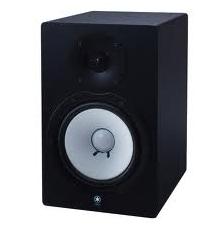AWESOME STUDIO MONITORS WITH MORE BOTTOM END
Great value! The HS80M is blatantly modeled after the legendary NS-10 near-field monitors. They have the same white cone and general design, but are made of modern materials and are powered with an awesome internal amplification system.
– Check the Amazon website here for more information on this product.
Big Brother Studio Monitors
Awesome studio monitors with more bottom end
Originally, I stepped into my local music shop to walk out with a sub to add onto my Event Reference 5 monitors. After two days of debating mixing techniques, acoustic theory and A-B-ing about a dozen near-field monitors, I walked out with a pair of the brand-spanking new Yamaha HS80M monitors. I didn’t even save my receipt.
What makes the HS80M such awesome monitors? That starts with the overall cabinet design. The speakers are mounted to the medium-density fiberboard cabinet with specific materials and methods to reduce shakes and resonance. Behind the 8” neopropylene woofer and 1” dome tweeter, two amplifiers are independently dedicated to drive their respective speaker for a total of 120Watts of power. On the back, a tuned port allows the woofer to breath, pushing more sound in your direction.
A huge benefit to the HS80M is the bi-amplification. The low-frequency amp drives the 8” woofer at 75W. The high-frequency amp drives the 1” tweeter at 45W. The crossover is set at 2kHz. This precisely delivers the right frequencies to the right part of the speaker, making for incredibly clear and precise sound.
These are near-field monitors, meaning they should be within decent proximity to the listener. Yamaha shows the right speaker placement and listening distance in the manual. But they also account for room anomalies in the design of the speaker. On the back of the cabinet, there are several controls to tailor the speaker for the room.
The Mid EQ gives a +2dB or –2dB option at 2kHz. This may come in handy if you know you have presence issues in your room, but I strongly recommend leaving it flat and learning your speaker-to-room relationship.
The Room Control switch attenuates the lower end by –2dB or –4dB at 500Hz. This is suggested if the speakers are against the wall or in corners, where the low-end can be accentuated by up to +3dB (heard as twice the loudness). Again, I strongly recommend leaving the room control at zero.
High Trim can boost or cut the speaker by 2dB at 2kHz. Unlike the Mid EQ, this lowers it like a low pass filter (LPF), meaning everything from 2kHz and up is affected. This may come in handy if the tweeters are at ear-level and need to be drawn back a hair.
Low Cut is a high pass filter (HPF), selectable at 80Hz or 100Hz. This is suggested if the speaker is against a wall or in a corner, but will substantially cut into your low end.
All four options are great to have, but can be dangerous when engaged. Your mixes may not translate. The natural, flat tone of the HS80M is great; you’re better off learning how the HS80M interacts with your room and experimenting with speaker positioning before messing with the EQ. The only time I would suggest engaging any of these features is if the speakers are not in similar positions (i.e. one is in the center of the room and other is more towards the corner). In that case, A-B the speakers with a sine wave or other constant signal, and mess with their controls until they sound the same.
The frequency response of the HS80M is 42Hz to 20kHz. Since I was originally shopping for subs, my biggest priority was low-end response. I wasn’t too thrilled with the frequency response ending at 42Hz, but sitting on top of my Auralex isolation pads, the low end is perfectly sufficient for my needs. My low-end mixes translate well to my truck, where I do the majority of my listening with my massive bandpass sub.
You’d be surprised what you can tell about your low end just by observing your speakers’ movement. If the woofer is shaking, but nothing is audible, you may have something happening at or below 20Hz. These kinds of observations are made easier with the HS80M’s white cone against the black cabinet.
Yamaha’s slogan for the HS series isn’t too reassuring: “If your mixes sound good on these, they’ll sound good anywhere.” That kind of suggests that these speakers suck. They don’t…they’re sick. Plug them in and let it those beats flow!
Technical Info:
Crossover frequency: 2kHz
Frequency response: 42Hz-20kHz
Watts: 120W dynamic power (75W LF driver, 45W tweeter)
Connectors: XLR and 1/4" balanced inputs
Speakers: 8" neopropylene woofer with low-damping rubber surrounds, 1" tweeter
Controls: Master level, Mid EQ, Room Control, High Trim, Low Cut
Price: $350 each
See the Amazon page for YAMAHA HS80M Review here

